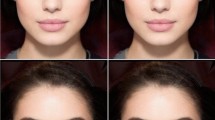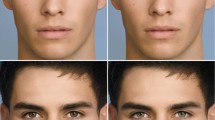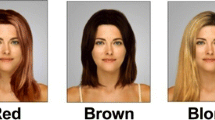Abstract
The human eye color blue reflects a simple, predictable, and reliable genetic mechanism of inheritance. Blue-eyed individuals represent a unique condition, as in their case there is always direct concordance between the genotype and phenotype. On the other hand, heterozygous brown-eyed individuals carry an allele that is not concordant with the observed eye color. Hence, eye color can provide a highly visible and salient cue to the child’s heredity. If men choose women with characteristics that promote the assurance of paternity, then blue-eyed men should prefer and feel more attracted towards women with blue eyes. To test these predictions, close-up photos of young women and adult men with either blue or brown eyes were rated for their attractiveness by young women and men observers with either blue or brown eyes (N=88). The eye color in the photographs of each model was manipulated so that a same face would be shown with either the natural eye color (e.g., blue) or with the other color (e.g., brown). Both blue-eyed and brown-eyed female participants showed no difference in their attractiveness ratings for male models of either eye color. Similarly, brown-eyed men showed no preference for either blue-eyed or brown-eyed female models. However, blue-eyed men rated as more attractive the blue-eyed women than the brown-eyed ones. We interpret the latter preference in terms of specific mate selective choice of blue-eyed men, reflecting strategies for reducing paternity uncertainty. In a second study, a group of young adults (N=443) of both sexes and different eye colors (blue, brown, and green) were asked to report the eye and hair color of their romantic partners. Their responses indicated the presence of assortative mating by eye color as well as, to a less degree, for hair color. Most importantly, blue-eyed male respondents were the group with the largest proportion of partners of same eye color. These findings 1) indicate that blue-eyed men do prefer women with the same eye color and 2) specifically suggest the presence of a male adaptation for the detection of extra-pair paternity based on eye color, as a phenotypically based assurance of paternity (i.e., when the father’s and offspring’s phenotypes match) as well as a defense against cuckoldry (i.e., when the phenotypes do not match).


Similar content being viewed by others
References
Alexander RD (1979) Darwinism and human affairs. University of Washington, Seattle, WA
Alexander RD, Noonan KM (1979) Concealment of ovulation, parental care, and human social evolution. In: Chagnon NA, Irons W (eds) Evolutionary biology and human social behavior: an anthropological perspective. Suxbury, North Scituate, MA, pp 402–435
Anderson KG (2006) How well does paternity confidence match actual paternity? Evidence from worldwide nonpaternity rates. Curr Anthropol 48:511–518
Apicella CL, Marlowe FW (2004) Perceived mate fidelity and paternal resemblance predict men’s investment in children. Evol Hum Behav 25:371-378
Ashton GC (1980) Mismatches in genetic markers in a large family study. Am J Hum Genet 32:601–613
Baker RR, Bellis MA (1995) Human sperm competition: copulation, masturbation and infidelity. Chapman & Hall, London, UK
Baumeister RF (2000) Gender differences in erotic plasticity: the female sex drive as socially flexible and responsive. Psychol Bull 126:347–374
Beals RL, Hoijer H (1965) An introduction to anthropology (3rd edn) MacMillan, New York
Beckman L (1962) Assortative mating in man. Eugen Rev 54:63–67
Betzig L (1989) Causes of conjugal dissolution: a cross-cultural study. Curr Anthropol 30:654–676
Bito LZ, Matheny A, Cruickshanks KJ, Nondahl DM, Carino OB (1997) Eye color changes past early childhood. The Louisville twin study. Arch Ophthalmol 115:659–663
Boas F (1928) Materials for the study of inheritance in man. Columbia University Press, New York
Bornstein MH (1973) Color vision and color naming: a psychophysiological hypothesis of cultural difference. Psychol Bull 80:257–285
Bryn H (1920) Researches into anthropological heredity: I. On the inheritance of eye-colour in man; II. The genetical relation of index cephalicus. Hereditas 1:186–212
Burks BS (1938) Objectivity of report in family studies of heredity: a preliminary analysis. J Heredity 29:505–509
Burley N (1982) The meaning of assortative mating. Ethol Sociobiol 4:191–203
Buss DM, Schmitt DP (1993) Sexual strategies theory: an evolutionary perspective on human mating. Psychol Rev 100:204–232
Cavalli-Sforza LL, Menozzi P, Piazza A (1994) The history and geography of human gene. Princeton University Press, Princeton, NJ
Cerda-Flores RM, Barton SA, Marty-Gonzales LF, Rivas F, Chakrborty R (1999) Estimation of nonpaternity in the Mexican population of Nuevo Leon: a validation study with blood group markers. Am Journal Phys Anthropol 109:281–293
Daly M, Wilson M (1982) Whom are newborn babies said to resemble? Ethol Sociobiol 3:69–78
DeBruine LM (2005) Trustworthy but not lust-worthy: context-specific effects of facial resemblance. Proc R Soc Edinb Sect B Biol Sci 272:919–922
Dolin PJ (1994) Ultraviolet radiation and cataract: a review of the epidemiological evidence. Br J Ophthalmol 78:478–482
Eiberg H, Mohr J (1996) Assignment of genes coding for brown eye colour (BEY2) and brown hair colour (HCL3) on Chromosome 15q. Eur J Hum Genet 4:237–241
Elston R (1961) Assortative mating in man. Transactions of the second international congress of human genetics, Rome
Feinman S, Gill GW (1978) Sex differences in physical attractiveness preferences. J Soc Psychol 105:43–52
Fisher ML (2004) Female intrasexual competition decreases female facial attractiveness. Biol Lett 271:283–285
Forgaard TS, Dzamarjia MT (2004) Innvandrerbefolkningen. In: Tronstad KR (ed) Innvandring og invandrere 2004, Statistisk Sentralbyrå, Oslo, Norway, pp 17–54
Frost P (2006) European hair and eye color: a case of frequency-dependent sexual selection? Evol Hum Behav 27:85–103
Fuster V (1984) Extramarital reproduction and infant mortality in rural Galicia (Spain). J Hum Evol 13:457–463
Gangestad SW, Simpson JA (2000). The evolution of human mating: trade-offs and strategic pluralism. Behav Brain Sci 23:573–644
Gangestad SW, Thornhill R, Garver CE (2002) Changes in women’s sexual interests and their partners’ mate-retention tactics across the menstrual cycle: evidence for shifting conflicts of interest. Proc R Soc Lond B 269:975–982
Gaulin SJC, Schlegel A (1980) Paternity confidence and paternal investment: a cross-cultural test of a sociobiological hypothesis. Ethology and Sociobiology 1:301–309
Gergen KJ (1967) The significance of skin color in human relations. Daedalus 96:390–406
Gladwell M (1999) True colors: hair dye and the hidden history of postwar America. New Yorker 3/22/99:70–81
Gloor PA, Houdaille J, Menk R (1981) Taille et couleur des yeux: 10’064 élèves de l’Ecole Polytechnique de Paris, 1794–1874. Archives Suisses d’anthropologie générale 45:17–29
Greiling H, Buss DM (2000) Women’s sexual strategies: the hidden dimension of extra-pair mating. Pers Individ Differ 28:929–963
Hasstedt SJ (1995) Phenotypic assortative mating in segregation analysis. Genet Epidemiol 12:109–127
Hrdy SB (1992) Fitness trade-offs in the history and evolution of delegated mothering with special references to wet-nursing, abandonment, and infanticide. Ethol Sociobiol 13:409–442
Hrdy SB (2000) Mother nature. Random House, London, UK
Hurst CC (1908) On the inheritance of eye-colour in man. Proc Roy Soc B 85–96
Jablonski NG (2004) The evolution of human skin and skin color. Annu Rev Anthropol 33:585–623
Jablonski NG, Chaplin G (2000) Skin deep. The Scientific American, October 2002, pp 74–81
Javitt JC, Taylor HR (1995) Cataract and latitude. Documenta Ophthamologica 88(3–4):307–325
Jorjani H, Engstrõm G, Liljedahl LE (1997) Genetic studies of assortative mating: a simulation study. I. Characteristics of the control populations. Acta Agric Scand 47:65–73
Kinsey AC, Pomeroy AB, Martin CE, Gebhard PH (1953) Sexual behavior in the human female. Saunders, Philadelphia
Koeslag JH, Koeslag PD (1994) Koinophilia. J Theor Biol 167:55–65
Laumann EO, Gagnon JH, Michael RT, Michaels S (1994) The social organization of sexuality. University of Chicago, Chicago, IL
Little AC, Penton-Voak IS, Burt DM, Perrett DI (2003) Investigating an imprinting-like phenomenon in humans: partners and opposite-sex parents have similar hair and eye colour. Evol Hum Behav 24:43–51
Lock-Andersen J, Wulf HC, Knudstorp ND (1998) Interdependence of eye and hair colour, skin type and skin pigmentation in a Caucasian population. Acta Derm Venereol (Stockholm) 78:214–219
Lykken DT, Tellegen A (1993) Is human mating adventitious or the result of lawful choice? J Pers Soc Psychol 65:56–58
Maddox KB (2004) Perspectives on racial phenotypicality bias. Pers Soc Psychol Rev 8:383–401
Maynard Smith J (1977) Parental investment: a prospective analysis. Anim Behav 25:1–9
McBurney DH, Simon J, Gaulin SJC, Geliebter A (2002) Matrilineal biases in the investment of aunts and uncles: replication in a population presumed to have high paternity certainty. Hum Nat 13:391–402
McLain DK, Setters D, Moulton MP, Pratt AE (2000) Ascription of resemblance of newborns by parents and nonrelatives. Evol Hum Behav 21:11–23
Miller GF, Todd PM (1998) Mate choice turns cognitive. Trends Cogn Sci 2:190–198
Neale MC, Neale BM, Sullivan PF (2002) Nonpaternity in linkage studies of extremely discordant sib pairs. Am J Hum Genet 70:526–529
Pagel M (1997) Desperately concealing father: a theory of parent–infant resemblance. Anim Behav 53:973–981
Pearson K (1907) Reply to certain criticisms of G.U. Yule. Biometrika 8:159–315
Pearson K, Lee A (1903) On the laws of inheritance in man: I. Inheritance of physical characters. Biometrika 2:357–462
Pena SDJ, Chakraborty R (1994) Paternity testing in the DNA era. Trends Genet 10:204–209
Perrett DI, Penton-Voak IS, Little AC, Tiddeman BP, Burt DM, Schmidt N, Oxley R, Barrett L (2002) Facial attractiveness judgments reflect learning of parental age characteristics. Proc R Soc Lond B 269:873–880
Platek SM, Burch RL, Panyavin IS, Wasserman BH, Gallup GG Jr (2002) Reactions to children’s faces: resemblance affects males more than females. Evol Hum Behav 23:159–166
Platek SM, Raines DM, Gallup GG Jr, Mohamed FB, Thomson JW, Myers TE, Panyavin IS, Levin SL, Davis JA, Fonteyn LCM, Arigo DR (2004) Reactions to children’s faces: males are more affected by resemblance than females are, and so are their brains. Evol Hum Behav 25:394–405
Post PW (1975) Cold injury and the evolution of “white” skin. Hum Biol 47:65–80
Price RA, Vanderberg SG (1980) Spouse similarity in American and Swedish couples. Behav Genet 10:59–71
Regalski JM, Gaulin SJC (1993) Whom are Mexican infants said to resemble? Monitoring and fostering paternal confidence in the Yucatan. Ethol Sociobiol 14:97–113
Regan S, Judge HE, Gragoudas ES, Egan KM (1999) Iris color as a prognostic factor in ocular melanoma. Arch Ophthalmol 117:811–814
Relethford JH, Lees FC, Byard PJ (1985) Sex and age variation in the skin color of Irish children. Curr Anthropol 26:396–397
Rife DC (1933) Genetic studies of monozygotic twins. J Heredity 24:407–414
Ritgers-Aris CAE (1973) A reflectance study of the skin in Dutch families. J Hum Evol 2:123–136
Sasse G, Muller H, Chakrborty R, Ott J (1994) Estimating the frequency of nonpaternity in Switzerland. Hum Hered 44:337–343
Schiefenhovel W (1989) Reproduction and sex-ratio manipulation through preferential female infanticide among the Eipo, in the highlands of western New Guinea. In: Rasa AE, Vogel C, Voland E (eds) The sociobiology of sexual and reproductive strategies. Chapman & Hall, New York, pp 170–193
Schmitt DP (2005) Fundamentals of human mating strategies. In: Buss DM (ed) The handbook of evolutionary psychology. Wiley, Hoboken, NJ, pp 258–291
Schmitt DP, Alcalay L, Allik J, Angleitner A, Ault L, Austers I et al (2004) Patterns and universals of mate poaching across 53 nations: the effects of sex, culture, and personality on romantically attracting another person’s partner. J Pers Soc Psychol 86:560–584
Shackelford TK (2003) Preventing, correcting, and anticipating female infidelity: three problems of sperm competition. Evolution and Cognition 9:90–96
Shackelford TK, LeBlanc GJ, Drass E (2000) Emotional reactions to infidelity. Cogn Emot 14:643–659
Sigusch V, Schmidt G (1971) Lower-class sexuality: some emotional and social aspects in West German males and females. Arch Sex Behav 1:29–44
Singh AD, Rennie IG, Seregard S, Giblin M, McKenzie J (2004) Sunlight exposure and pathogenesis of uveal melanoma. Surv Ophthalmol 49:419–428
Solomon GEA, Johnson SC, Zaitchik D, Carey S (1996) Like father, like son: young children’s understanding of how and why offspring resemble their parents. Child Dev 67:151–171
Sykes B, Irven C (2000) Surnames and the Y chromosome. Am J Hum Genet 66:1417–1419
Symons D (1995) Beauty is in the adaptations of the beholder: the evolutionary psychology of human female sexual attractiveness. In: Abramson PR, Pinkerton SD (eds) Sexual nature, sexual culture. The University of Chicago, Chicago, pp. 80–118
Thiessen D, Young RK, Delgado M (1997) Social pressures for assortative mating. Pers Individ Differ 22:157–164
Trivers R (1972) Parental investment and sexual selection. In: Campbell B (ed) Sexual selection and the descent of man: 1871–1971. Aldine, Chicago, pp. 136–179
Van den Berghe PL, Frost P (1986) Skin color preferences, sexual dimorphism, and sexual selection: a case of gene-culture co-evolution? Ethn Racial Stud 9:87–113
Vinding T (1990) Pigmentation of the eye and hair in relation to age-related macular degeneration. An epidemiological study of 1000 aged individuals. Acta Ophthalmol 68(1):53–58
Walster E, Aronson V, Abrahams D, Rottman L (1966) Importance of physical attractiveness in dating behaviour. J Pers Soc Psychol 4:508–516
Wiederman MW (1997) Extramarital sex: prevalence and correlates in a national survey. J Sex Res 34:167–174
Widemo F, Sæther SA (1999) Beauty is in the eye of the beholder: causes and consequences of variation in mating preferences. Trends Ecol Evol 14:26–31
Williams GC (1975) Sex and evolution. Princeton University Press, Princeton, NJ
Willoughby RR (1933) Somatic homogamy in man. Hum Biol 5:690–705
Wilson GD, Barrett PT (1987) Parental characteristics and partner choice: Some evidence for oedipal imprinting. J Biosoc Sci 19:157–161
Zanetti R, Rosso S, Martinez C, Navarro C, Scraub S, Sancho-Garnier H et al (1996) The multicentre south European study “helios” I: skin characteristics and sunburns in basal cell and squamous cell carcinomas of the skin. Br J Cancer 73:1440–1446
Zei GP, Astolfi P, Jayakar SD (1981) Correlation between father’s age and husband’s age: a case of imprinting. J Biosoc Sci 13:409–418
Acknowledgments
We thank Dick Alexander and Ivar Folstad for their comments on drafts of this article and Raul Primicerio for introducing us to the “evolutionary games”. Thanks also go to many students and friends for lending their faces to the camera and disclosing to us their romantic lives. The participants were treated in accordance with the ‘Ethical Principles of Psychologists and code of Conduct’ (American Psychological Association, 1992).
Author information
Authors and Affiliations
Corresponding author
Additional information
Communicated by T. Czeschlik
Electronic supplementary material
Below is the link to the electronic supplementary material.
S1
Evolutionary games (XLS 914 kb)
Rights and permissions
About this article
Cite this article
Laeng, B., Mathisen, R. & Johnsen, JA. Why do blue-eyed men prefer women with the same eye color?. Behav Ecol Sociobiol 61, 371–384 (2007). https://doi.org/10.1007/s00265-006-0266-1
Received:
Revised:
Accepted:
Published:
Issue Date:
DOI: https://doi.org/10.1007/s00265-006-0266-1




